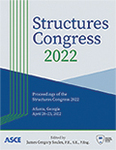Design Behavior: How to Save Our Planet and Influence People
Publication: Structures Congress 2022
ABSTRACT
Human actions have, and continue to, cause changes to our climate. The built environment sector is disproportionately responsible for present greenhouse gas emissions, and thus structural engineers have a unique opportunity to reduce the quantity of future greenhouse gas emissions. Emission reductions can be realized through building less, refurbishing more, appropriate lean design, completing life cycle assessments at early stages, designing with low-carbon materials, and applying circular economy principles to new designs and material life cycles. However, the construction industry is risk-averse, and engineers often defer to previous familiar historic design methods, which do not reduce greenhouse gas emissions. This paper proposes applying knowledge from the field of Behavioral Economics to the structural engineers’ quotidian design workflow to allow engineers to realize emission reductions. Recently implemented changes to the workflow at Schlaich Bergermann Partner (sbp) are discussed, in addition to planned actions within sbp and the industry at large.
Get full access to this article
View all available purchase options and get full access to this chapter.
REFERENCES
American Society of Civil Engineers. 2021. ASCE issues climate change statement, urging UN action. Accessed November 7th, 2021. https://www.asce.org/publications-and-news/civil-engineering-source/article/2021/10/31/asce-issues-climate-change-statement-urging-un-action.
Archer-Jones, C., and D. Green. 2021. “Carbon Targets for Bridges: a Proposed SCORS-style rating scheme.” The Structural Engineer (The Institution of Structural Engineers) 99 (10): 14–18.
Arnold, W., M. Cook, D. Cox, O. Gibbons, and J. Orr. 2020. “Setting Carbon Targets: an Introduction to the Proposed SCORS rating scheme.” The Structural Engineer (The Institution of Structural Engineers) 98 (10): 8–12.
Booth, E. 2020. How Should a Green and Resilient Recovery Work in Practice? London, UK: Architects’ Journal, June 18.
Bragança, L., S. M. Vieira, and J. B. Andrade. 2014. “Early Stage Design Decisions: The Way to Achieve Sustainable Buildings at Lower Costs.” The Scientific World Journal (Hindawi Publishing Corporation) 2014. doi:https://doi.org/10.1155/2014/365364.
Brütting, J., C. Vandervaeren, G. Senatore, N. De Temmerman, and C. Fivet. 2020. “Environmental Impact Minimization of Reticular Structures Made of Reused and New Elements Through Life Cycle Assessment and Mixed-Integer Linear Programming.” Energy & Buildings (Elsevier) 215.
CIRCuIT. 2019. About the Project. Accessed November 7th, 2021. https://www.circuit-project.eu/about-circuit.
Circular Economy Working Group., in press. “Circular Economy.” SEI Sustainability Committee. https://seisustainability.org/working-groups/.
de Wit, M., J. Hoogzard, S. Ramkumar, H. Friedl, and A. Douma. 2018. The Circularity Gap Report: An analysis of the circuclar state of the global economy. Amsterdam: Circle Economy.
Enhanced Commercial Property Database. 2020. Building Age Data Year-End 2020. Hackettstown, NJ: SMR Research Group.
EPA, US. 1990. “Clean Air Act Amendments.” https://www.epa.gov/clean-air-act-overview/clean-air-act-text.
Falk, R. H, S. Cramer, and J. Evans. 2013. “Framing Lumber from Building Removal: How Do We Best Utilize this Untapped Structural.” Forest Products Journal 62 (7/8): 492–499.
Gandy, K., R. Persian, D. Gibbons, J. Watson, and R. Akbari. 2019. Encouraging Earlier Tax Returns in Indonesia. Policy Brief, London, UK: The Behavioural Insights Team.
Gibbons, O., and J. Orr. 2020. How to Calculate Embodied Carbon. London, UK: The Institution of Structural Engineers.
Gowler, P., and W. Arnold. 2021. “An Introduction to The Structural Carbon Tool.” The Structural Engineer 99 (3). Accessed November 7th, 2021.
Hallsworth, M., and E. Kirkman. 2020. Behavioral Insights. Cambridge, Massachussets: The MIT Press.
Hawkins, W., S. Cooper, S. Allen, J. Roynon, and T. Ibell. 2021. “Embodied Carbon Assessment Using a Dynamic Climate Model: Case-Study Comparison of a Concrete, Steel and Timber Building Structure.” Structures (The Institution of Structural Engineers) 33: 90–98.
Intergovernmental Panel on Climate Change. 2021. Climate Change 2021: The Physical Science Basis. Nairobi, Kenya: United Nations Environment Programme.
Jeseritz, C. 2021. “The SEI SE 2050 One-Year Anniversary.” STRUCTURE Magazine, November: 24–25.
Liebsch, T. 2020. Life Cycle Assessment Software Tools - Overview. Accessed November 7th, 2021. https://ecochain.com/knowledge/life-cycle-assessment-software-overview-comparison/.
MacDonald, E. F., and J. She. 2015. “Seven Cognitive Concepts for Successful Eco-Design.” Journal of Cleaner Production 92: 23–36.
Powell, M. 2020. Structural engineers declare climate and biodiversity emergency. Accessed November 7th, 2021. https://www.istructe.org/structural-engineers-declare/.
Mazria, E., and V. Martinez. 2021. “CarbonPositive: Accelerating the 2030 Challenge to 2021.” ARCHITECT, July 2. https://www.architectmagazine.com/technology/carbonpositive-accelerating-the-2030-challenge-to-2021_o.
Report of the International Expert Panel on Behavioral Science for Design. 2019. Twenty Questions About Design Behavior for Sustainability. Nature Sustainability.
Ribeirinho, M. J., J. Mischke, G. Strube, E. Sjödin, J. Luis Blanco, R. Palter, J. Biorck, D. Rockhill, and T. Andersson. 2020. The Next Normal in Construction. Chicago, Illinois: McKinsey and Company.
Rose, C. M., D. Bergsagel, T. Dufresne, E. Unebreme, T. Lyu, P. Duffour, and J. A. Stegemann. 2018. “Cross-Laminated Secondary Timber: Experimental Testing and Modelling the Effect of Defects and Reduced Feedstock Properties.” Sustainability (MDPI) 10.
sbp. 2021. About Us. Accessed November 7, 2021. https://www.sbp.de/en/about-us/.
The Behavioural Insights Team. 2014. EAST: Four Simple Ways to Apply Behavioural Insights. London, UK: BIT.
United Nations Environment Programme. 2020. 2020 Global Status Report for Buildigns and Construction: Towards a Zero-emission, Efficient and Resilient Buildings and COnstruciton Sector. Nairobi, Kenya.
Witynski, M. n.d. What is Behavioral Economics? Accessed November 7th, 2021. https://news.uchicago.edu/explainer/what-is-behavioral-economics#behavioralecon.
Information & Authors
Information
Published In
History
Published online: Apr 18, 2022
Authors
Metrics & Citations
Metrics
Citations
Download citation
If you have the appropriate software installed, you can download article citation data to the citation manager of your choice. Simply select your manager software from the list below and click Download.
